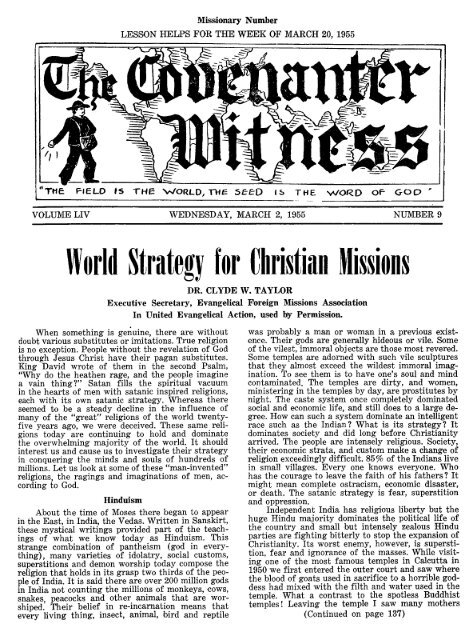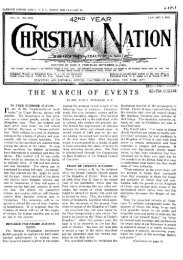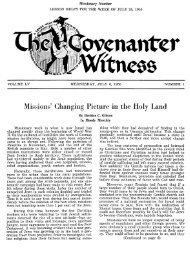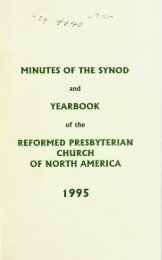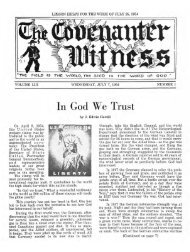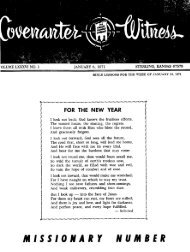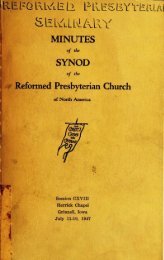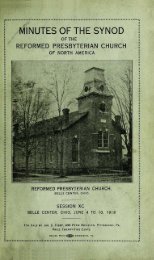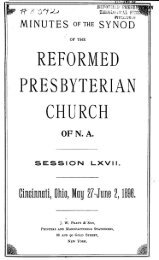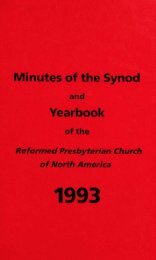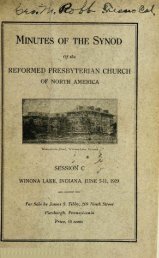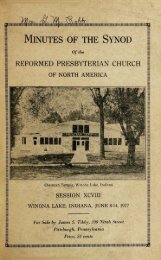Covenanter Witness Vol. 54 - Rparchives.org
Covenanter Witness Vol. 54 - Rparchives.org
Covenanter Witness Vol. 54 - Rparchives.org
You also want an ePaper? Increase the reach of your titles
YUMPU automatically turns print PDFs into web optimized ePapers that Google loves.
Missionary Number<br />
LESSON HELPS FOR THE WEEK OF MARCH 20, 1955<br />
THE FIELD IS TH WORLD,<br />
THE 5/rtD IS THE WORD OP GOD<br />
"<br />
VOLUME LIV WEDNESDAY, MARCH 2, 1955 NUMBER 9<br />
World Strategy<br />
DR. CLYDE W. TAYLOR<br />
for Christian Missions<br />
Executive Secretary, Evangelical Foreign Missions Association<br />
In United Evangelical Action, used by Permission.<br />
When something is genuine, there are without<br />
doubt various substitutes or imitations. True religion<br />
is no exception. People without the revelation of God<br />
through Jesus Christ have their pagan substitutes.<br />
King David wrote of them in the second Psalm,<br />
"Why do the heathen rage, and the people imagine<br />
a vain thing" Satan fills the spiritual vacuum<br />
in the hearts of men with satanic inspired religions,<br />
each with its own satanic strategy. Whereas there<br />
seemed to be a steady decline in the influence of<br />
many of the "great" religions of the world twentyfive<br />
years ago, we were deceived. These same reli<br />
gions today are continuing to hold and dominate<br />
the overwhelming majority of the world. It should<br />
interest us and cause us to investigate their strategy<br />
in conquering the minds and souls of hundreds of<br />
millions. Let us look at some of these "man-invented"<br />
religions, the ragings and imaginations of men, ac<br />
cording to God.<br />
Hinduism<br />
About the time of Moses there began to appear<br />
in the East, in India, the Vedas. Written in Sanskirt,<br />
these mystical writings provided part of the teach<br />
ings of what we know today as Hinduism. This<br />
strange combination of pantheism (god in every<br />
thing), many varieties of idolatry, social customs,<br />
superstitions and demon worship today compose the<br />
religion that holds in its grasp two thirds of the peo<br />
ple of India. It is said there are over 200 million gods<br />
in India not counting the millions of monkeys, cows,<br />
snakes,<br />
peacocks and other animals that are wor<br />
Their belief in re-incarnation means that<br />
every living thing, insect, animal, bird and reptile<br />
was probably a man or woman in a previous exist<br />
ence. Their gods are generally hideous or vile. Some<br />
of the vilest, immoral objects are those most revered.<br />
Some temples are adorned with such vile sculptures<br />
that they almost exceed the wildest immoral imag<br />
ination. To see them is to have one's soul and mind<br />
contaminated. The temples are dirty, and women,<br />
ministering in the temples by day, are prostitutes by<br />
night. The caste system once completely dominated<br />
social and economic life, and still does to a large de<br />
gree. How can such a system dominate an intelligent<br />
race such as the Indian What is its strategy It<br />
dominates society and did long before Christianity<br />
arrived. The people are intensely religious. Society,<br />
their economic strata, and custom make a change of<br />
religion exceedingly difficult. 85% of the Indians live<br />
one knows everyone. Who<br />
in small villages. Every<br />
has the courage to leave the faith of his fathers It<br />
might mean complete ostracism, economic disaster,<br />
or death. The satanic<br />
strategy is fear, superstition<br />
and oppression.<br />
Independent India has religious liberty but the<br />
huge Hindu majority dominates the political life of<br />
the country and small but intensely zealous Hindu<br />
parties are fighting bitterly to stop the expansion of<br />
Christianity. Its worst enemy, however, is supersti<br />
tion, fear and ignorance of the masses. While visit<br />
ing one of the most famous temples in Calcutta in<br />
1950 we first entered the outer court and saw where<br />
the blood of goats used in sacrifice to a horrible god<br />
dess had mixed with the filth and water used in the<br />
temple. What a contrast to the spotless Buddhist<br />
temples! Leaving the temple I saw many mothers<br />
(Continued on page 137)


